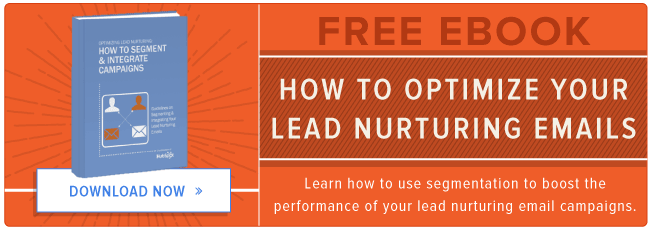Not everyone is ready to buy your product or service the first time they come to your site and that’s okay. With the right amount of time and information they will warm up to your brand, assuming they’re the right persona for your product or service, of course.

Nurturing campaigns are essential for keeping people who visit your site but aren't ready to immediately buy engaged with your brand. Essentially these campaigns are a series of emails aimed at keeping you top of mind while building trust and moving your lead further along the buyer's journey.
There are various types of nurturing workflows based on who you are targeting and the length of each work flow (both in terms of numbers of emails and total days in between sends). Regardless of who you are targeting or the length of your workflow, there are four basic goals you want to accomplish with each nurturing campaign:
- Create brand awareness and establish a sense of trust through helpful content.
- Address one of their pain points and offer content that may help them solve this problem either through blog posts or an ungated piece of content.
- Offer a longer, gated piece of content, like an ebook or a guide, that relates specifically to you and your brand.
- Get the lead to contact you to inquire more about your services/product or make the purchase online.
For companies in the B2B space, there are six main workflows that are essential to use in order to convert more leads into customers.
1) Subscriber Workflows
A subscriber workflow is when recent subscribers to your blog/newsletter receive an email which provides additional information about your brand or shares recent updates with them. This type of workflow is important because it makes subscribers feel welcomed to your brand, defines what to expect from you, and may even contain a piece of content that converts them to a lead.
This workflow is typically just one email, known as the 'welcome email', which should include a number of different components. First and foremost, it should thank subscribers for their interest and show them that they're valued. It should also let them know what to expect from your company such: as how many times will you email them? Will they be emailed every time your company publishes a new blog, or will it be in a weekly or monthly roundup? Let them know so they can update their preferences if they'd like.
Including a relevant CTA is useful- just make sure it's subtle and not salesy. They've already subscribed to your blog where they'll see plenty of your company's content, you don't need to be overly promotional here.
2) Lead Nurturing Workflows
A lead nurturing workflow functions with the end goal of converting leads into marketing qualified leads (or MQLs), which in turn brings them further down the sales funnel, and one step closer to becoming a customer. It's important to have this be an automated email string because people want to know more about you and build trust before making a decision to purchase. You can set this workflow up to look something like the following once a website visitor becomes a lead:
- Email 1, TOFU Offer: Delay 3 days. Promote an offer that relates to the one that they became a lead from. Maybe they downloaded an infographic on Growth-Driven Design, so you would then want to send them another TOFU offer, such as a blog post. This should be more of a an awareness level offer for someone who's at the beginning stages of the buyer's journey.
- Email 2, MOFU Offer: Delay 3 days. You should promote a MOFU offer, like an ebook or case study, related to what they originally downloaded. This offer can get more specific as to the products and services you offer.
- Email 3, BOFU Offer: Delay 3 days. The last email to the workflow would be a BOFU offer such as a free consultation, review, trial or demo.
This simple workflow will help leads move naturally through the sales cycle without looking to salesy or pushy on your end and leading to the dreaded "unsubscribe."
3) Hot Leads Workflows
A 'hot lead' is someone who is frequently visiting your website, opening your emails and engaging with you on social media which indicates that you’ve clearly got their interest. Hold onto that interset by keeping them engaged with your company.
A workflow for someone who is actively viewing and sharing your content could be:
- Email 1: BOFU offer like a case study. This is a great offer to send someone who is almost-ready to make a sale and should be related to the topics they've been viewing most on your site
- Email 2: Offer your lead a free service, such as a consultation, demo or review for what they need help with.
- Email 3: If they took advantage of the free service, the next and final email should aim to get the lead on a call with your sales team.
4) Cold Leads Workflows
So, maybe your lead fell asleep on you… wake them up with a workflow! Maybe earlier in the process they weren’t in the condition to buy, but things have changed and now they’re ready, but you haven't followed up with them in a while.
Creating a workflow to remind them you’re still there and on their side is a great way to engage them again. To respark their interest you can send them some company updates or special offers, as listed below.
- Option 1: What's new with your business? Is there an exclusive offer you can send them that'll get them excited about your brand?
- Option 2: Email them a survey. What kind of experience did they have with your company the last time they interacted?
- Option 3: We're thinking abot you.. are you thinking about us? You can get fun with this email. Talk to your leads like they're people- believe me, they'll respond better to this. Tell them about a product/service they may be interested in based off of their prior page views and downloads.
5) Customer Workflows
They've become a customer, but you're not done with them yet! You want to encourage them to continue to interact with your brand. It's an important workflow to use because it keeps customers thinking about your brand in hopes that they become repeat customers and evangelists. A simple customer workflow could resemble the following:
- Email 1: Delay one day after becoming a customer. The first email in the workflow should thank customers for making their purchase. Be sure to include company news to keep readers in the loop about what's going on. Invite them to add your company on social media. This will also encourage engagement.
- Email 2: Delay three weeks. In this email, you can ask your customer how their product/service they purchased from you is going. This makes sure you're delighting them and keeping customers happy. If they aren't happy, this allows you to fix it and make it right. Your customers will really feel taken care of if you include an email or phone number they can send questions or concerns to.
- Email 3: Delay 2-3 months. Use this as an opportunity to promote making an upgrade or another purchase. You can push this through promo specials and discounts.
6) Industry/Specific Topics Workflows
Knowing what industry your prospect is in is a golden piece of information. By knowing this, you can send them content specifically for them. By sending the right content to the right people, you're more likely to convert. Check out where this lead came from. Was it for an offer specific to a certain industry? What kind of tradeshow did you meet them at? Answer these questions to segment them for this workflow.
After discovering what industry a prospect is in, send them workflows in this progression:
- Email 1: Send them relevant blogs.
- Email 2: White papers, videos, checklists, guides, etc.
- Email 3: Webinars, case studies, ebooks, how-to videos, etc.
- Email 4: Demo, assessments, consultation, reviews, etc.
By basing these emails off of industry or specific topics of interest, you will provide your leads with valuable and relevant information.
The Key Takeaway
You know they’re interested in you; now it’s time to capitalize on it. By sending your contacts workflows based on their buyer persona and life cycle stage, you’ll decrease your sales cycle by 23% according to Market2Lead. That’s right-- 23%! So start segmenting your contacts into lists and target them with those workflows!
Want to learn from Bluleadz? Download their guide on Email Marketing.





![Email Automation: How to Set Up Automated Workflows [Data]](https://blog.hubspot.com/hubfs/email%20automation.jpg)




